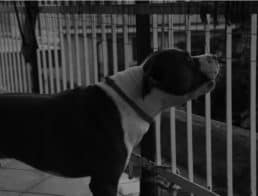Few things fill a dog owner’s mind with dread more than the thought of their dog running away. It’s unpleasant to even think about, let alone to experience in real life.
Fortunately, there’s a lot you can do to prevent this from happening. In addition to keeping any fencing you have in good repair, you can add the extra security of training your dog to stay in your yard. In the following guide, you’ll learn about four popular training methods you can use to help ensure your dog doesn’t get lost.
1. Train Your Dog with a GPS Dog Tracker

Using a high-tech GPS dog tracker to train your dog to stay in the yard is one of the easiest methods available to dog owners. So how exactly can you use this nifty device to ensure your dog doesn’t dash off? By setting up a geofence with it. While not every GPS dog tracker comes equipped with this function, many do, so you won’t have trouble finding one that fits the bill.
A geofence is a virtual fence that creates a boundary within which your dog must stay. If your dog tries to cross it, the GPS dog tracker will send a signal to your dog, such as a sound or a vibration, that they’re about to make a bad choice. If they continue, some collars follow up with a small electric shock. These signals are enough to stop many dogs from continuing with their escape act, but if they do cross the boundary, the system will alert you to this fact.
The beauty of a geofence is that you can easily set it up and change it whenever you need to via your mobile phone. However, like any of the other methods mentioned in this guide, setting a geofence with a GPS dog tracker isn’t a foolproof method for keeping your dog in your yard and it does require some training. Because you may need to pay a monthly subscription in addition to the cost of the collar, it can be relatively more expensive than other training methods.
That said, many dog owners have found this to be an effective method of keeping their dogs in their yard.
2. Train Your Dog with an Electronic Fence

Photo courtesy: Pixabay Public Domain
An electronic fence, also called an invisible fence, is an electronically-wired fence that is usually installed underground. Similar to a GPS system with geofence functionality, your dog will need to wear a collar that will give them a signal (often a beep) to let them know if they’re approaching the boundary and a deterrent (usually a light shock) if they are about to cross over the line. With some systems, you’ll also get an alert if they manage to leave your yard.
While this method sounds ideal, electronic fences do have some disadvantages.1 So be sure to familiarize yourself with them before deciding whether this method is right for you and your dog.
3. Boundary Training
Alone, boundary training won’t prevent most dogs from exiting their yard if their reasons for doing so are compelling enough (squirrel!), but it is an essential addition to using either a GPS dog tracker or an electronic fence.
Here’s a quick guide to boundary training:
To begin, mark a boundary around your yard with flags. Set the flags at the point where your dog’s GPS or electronic fence collar will alert them that they are approaching the edge of their yard (often when the beep is emitted). Then, put your dog on their leash and walk them around the boundary you’ve set.
If your dog crosses the flag line, stop walking, say “no,” and tug gently on their leash to signal for them to stop. They should also be wearing their GPS or electronic fence collar so they hear the beep around the same time that you inform them that they should go no further. Positive reinforcement is key to this method, so be sure to praise and reward your dog with treats when they stay within the boundary.
As you can imagine, your dog won’t learn to stay within the boundary overnight. It will require several weeks for most dogs to undergo successful training. Keep in mind that the more regularly you’re able to practice, the quicker you’ll see results.
4. Shock Collar Training
The final method to touch on is shock collar training. We won’t go into too much detail about this method because it is quite controversial.
Shock collars are a type of electronic collars that come with varying levels of shock. While GPS dog collars and the collars that come with electronic fences may also have a shock option, they are generally not as intense as the levels that some shock collars, also known as e-collars, can inflict.
Some dog owners choose to use a shock collar as it may seem like they provide a relatively quick and easy way to train your dog to stay in the yard. However, training using a shock collar is considered to be an aversive training technique. The American Animal Hospital Association (AAHA) recommends that this method should not be used to “either teach or alter behavior.” 2
Aversive training techniques have been shown to cause dogs to display more stress-related behaviors and lead to higher post-training increases in cortisol levels, among other negative side effects.3 So, while some owners do use shock collars, it is not an option that veterinarians and other experts generally recommend.
Final Words
Preventing dogs from escaping their yards is vital to their safety. Before choosing to use a physical fence or one of the systems mentioned above, make sure you have a good understanding of the strengths and weaknesses associated with each option.
- Buzhardt L. The pros and cons of invisible fences for dogs. Vcahospitals.com. Accessed February 23, 2021.
- AAHA. Changing behaviors. Aaha.org. Accessed February 23, 2021.
- Vieira de Castro AC, Fuchs D, Morello GM, Pastur S, de Sousa L, Olsson IAS. Does training method matter? Evidence for the negative impact of aversive-based methods on companion dog welfare. PLoS ONE. 2020;15(12). doi: 10.1371/journal.pone.0225023














